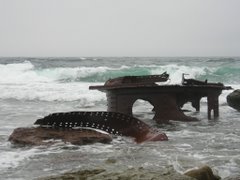
One of the things that really helped me become a salmon fisherman was having a friend who knew the sport. Dennis McKinnon was the embodiment of years of experience and generations of angling lore, all rolled into one awesome package, and he was my next-door neighbor for 15 years. Dennis could see salmon in our peat-stained water, partly because he knew where to look and partly because he knew what to look for. The first time I ever saw a salmon underwater, I was with Dennis.
"Let's take a run upriver," he said, "I've got an idea where you might get a hold o' one." In minutes, my rod, vest, and net were in the back of Dennis' Dodge Ram pickup, and we were bouncing over the dusty road on the east side of the river.
"Where are we headed?" I inquired.
"High Rock," came the reply. "This time o' year, nobody fishes it. You might just get lucky!" Dennis parked and led me through the woods to the river, across stepping stones to the very brink of a 'dump', where the water tumbled down. The morning sun stood well above the pines.
"There they are," he whispered. There's a salmon and three grilse layin' there." I peered into the dark water, adjusting my hat and polarized glasses, but could see nothing that looked like a fish, much less four of them.
"See 'em?" Dennis continued. "The salmon's got a mark on his back." I looked again. Below the surface, I could just make out the shapes of the large rocks that formed the riverbed.
"You've gotta' look hard," he encouraged. "Our river's not clear; it's kinda' brown, from the bogs. Look just behind the rock, here," he pointed.
"Which rock, Dennis?" I asked. "There's nothing but rocks here."
"The one we're standin' on!" he answered.
Then I saw... where the current swept around the rock, an eddy line creased the surface and, beneath that line, but a few feet away, I saw the fish! They were nearly invisible - only a faint, ghostly outline could be seen, so perfectly did they blend with the river bottom. Close enough to touch with a wading staff, yet, seemingly, unperturbed by our presence, occasionally, one would twitch his tail like a cat, or drop his jaw, displaying a milk-white mouth. Gingerly, we backed away and sat down on a rock.
Yes, there's more to the story, but it's too long for this blog. Anyone who's curious can find it in the sidebar item called "The Yarn Bin". Learning to see salmon is something I've worked on for many years since that day. Here's some of what I've learned:- Assume that there are salmon in the pool - assume that they can see you.
- Be prepared to invest some time in looking for salmon, at least half an hour. You may get lucky and see one in the first minute - usually, and especially for beginners, your eyes need to adjust to the task.
- The best time to see into water is on a sunny day from 11AM to 1PM.
- Wear a pair of polarized sunglasses and a hat with a wide brim. Try different colored lenses - I like a slight brown tint, but grey or green can also be good.
- Approach the pool slowly, stay low - don't make any sudden moves.
- Get to the highest vantage point and slowly stand upright.
- Standing with your feet apart and level, if possible, shift your weight slowly from foot to foot.
- Mentally, place a grid on the river and divide the stream bottom into sectors - give each sector careful scrutiny. Look for landmarks - submerged logs, rocks, weed growth.
- Look for shadows on the streambed - this can be your best clue - the fish may be almost invisible, but if the sun is out, there will be a telltale shadow underneath.
- Watch for movement - salmon change positions slightly, adjust their fins, open their mouths, - sometimes they leave their lies, circle the pool and come right back into formation.
- Learn to look for windows into the streambed. By this, I mean the surface of the water may be braided with current and flecks of foam. If you stare at one spot, you will only get split-seconds of clarity. Instead, look for calm spots in the flow - patches that are relatively free of turbulence and use them as lenses. Lock your gaze on one of these moving windows and you may get a few seconds of clarity as it sweeps past you.
There's more to it than that, obviously, but these tips should get you started on the road to seeing more salmon.
"You should see what I saw!"- sign in Lawrence Melanson's workshop.
Photo by W. R. MacAskill, "Medway River 1933" Nova Scotia Archives and Records Management.













